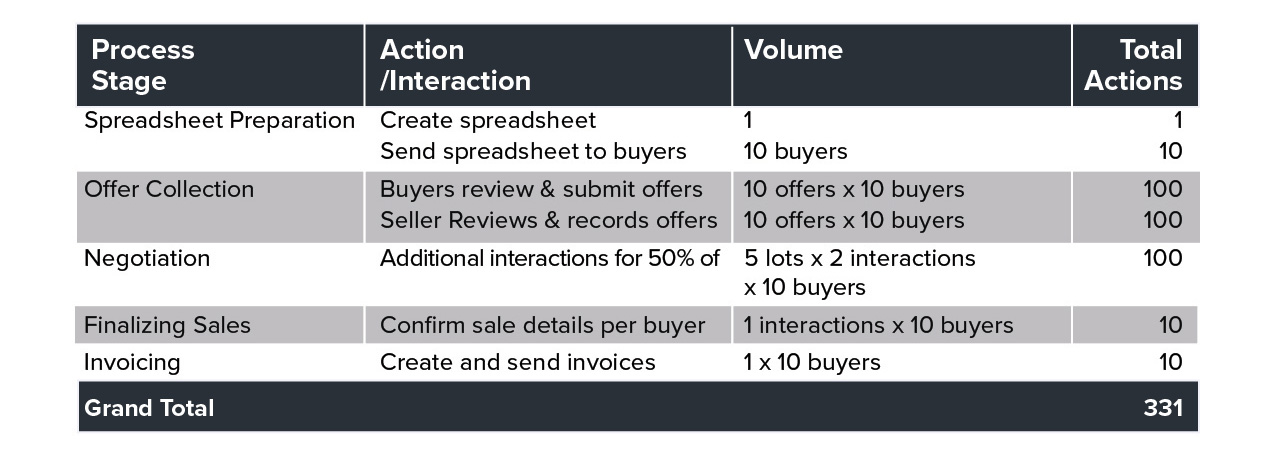One of my favourite memories from my first RLA Las Vegas event in 2023 was a casual conversation with Anya Skomorokhova, CEO of PorterLogic while we waited for the bus to the Top Golf event. We went through the usual “what do you do?” introduction, but it was Anya’s answer to that question that really stuck with me (and made me wish I’d thought of it myself):
“We get you out of spreadsheet hell.”
That single sentence cut through the jargon and helped me instantly picture the before-and-after scenarios for Anya’s clients.
It also resonated because it mirrors what we do at Bidpath. Many of our clients originally relied on emailing spreadsheets to buyers and simply selling to the highest bidder. We replace that manual approach with an automated, scalable platform that includes an audit trail and competitive bidding.
It also made me realise that countless SaaS companies around the world share this goal: to “get you out of spreadsheet hell.” Whether replacing a spreadsheet-based system or a broader manual process, many of these tools have become part of our daily routines.
While we’ve embraced alternatives in some areas—like CRMs, accounting systems, and business intelligence—spreadsheets still linger in others. Often, this happens simply because we’re unaware of the available options.
If you’re still relying on spreadsheets for these tasks, it’s worth asking: is there a better way?

What’s Wrong with Spreadsheets
Nothing - spreadsheets are great for what they were designed for. However - there are many areas that you wouldn’t even consider using a spreadsheet when there are better options out there. Reddit user ‘Corporate_Jesus’ puts it better than I could in a response to a post requesting how to make a CRM in Excel:
“This is like asking for advice on a new typewriter. You deserve better than Excel sheets as a CRM.”
In the past, many of us did run a CRM, or BI, or project management through a spreadsheet or highly manual process. But we’ve come to realise that there are better tools for the job, and I doubt you would want to go back.
And it’s not just these tools. In general, be wary of what you do and don’t use spreadsheets for, and bear in mind the following.
Spreadsheets are great for:
- Visualising and analysing complex information
- Creating and maintaining relatively static (i.e. not real-time) data
- Facilitating some level of interaction between team members
Spreadsheets are NOT great for:
- Sharing data in a controlled manner between multiple parties with varying access restrictions
- Ensuring data is accessible and integrated across multiple systems, both inside and outside a company
- Managing highly interactive or dynamic processes that require instant feedback, such as price bidding
- Scaling to handle large volumes of data and users while providing a reliable audit trail
The Before and The After
We all have a pretty clear picture of our lives before and after we move away from a manual or spreadsheet-based process. Here are some relatable examples that have had a meaningful impact on the way we work day-to-day.
Signing Contracts
- Before: Yes I want you to print out, fill in, sign, then scan and email this document back to me. No, I’m not joking.
- After: Life without Docusign or Pandadoc is hard to imagine.
Expenses
- Before: I once received a letter from Royal Mail (the UK postal system) apologising that a snail had eaten my expense receipts. Case closed.
- After: Photograph. Categorise. Done. I’d recommend Dext, but there are similar options.
Staff Leave Planning
- Before: The human resources equivalent of co-ordinating a small-scale military invasion.
- After: Clear calendar view, automatic clash detection, rules-based booking and instant approval.
By thinking about the areas we’re already familiar with, you can see how impactful the results can be when we make a change to a more efficient system.

What about the RLA?
As more SaaS solutions are released every year, countless examples can be found that streamline many day-to-day business processes.
I’ll stick with the example I know best, and one that is highly relevant to the Reverse Logistics Association – the process of selling large volumes of retail returns, overstock, or general surplus inventory.
We know from the 2024 Returns Liquidation Survey we completed in partnership with the Reverse Logistics Association (link to report for members here: https://rla.org/product/1327), that if you are a manufacturer, you are more likely to sell pallets or truckloads of returns with a manual process: send a spreadsheet to a group of buyers and sell to the highest bidder.
The reasons manufacturers gave in the survey included:
- You want to sell privately, not publicly
- You want to restrict the bidder group to a small number of trusted buyers
- You want to set specific terms of resale (e.g. export only, restricted ecommerce or marketplace sales)
- You want to avoid channel conflict, competing with your own returns on primary sales channels, and/or trying to prevent negative feedback from third-party sellers selling returns through the same channels.
And while manufacturers arguably stand to lose the most and may prioritise these risks the highest, retailers, insurance firms, wholesalers and others often must sign up to these same terms to be able to handle a specific manufacturer’s items.
The reason this is a manual process? Much like the examples above, you may simply be unaware of the available alternatives.
We know from our own clients that a staggering amount of efficiency can be gained when shifting from a manual process to a platform for selling large volumes of returns. It’s not about replacing people—relationships and trust remain key to successful resale. Instead, the focus is on scalability, with added benefits like robust data insights, a clear audit trail, and higher recovery rates through competitive bidding.
Table 1 below shows the number of touchpoints for a sale using a manual approach, assuming you only have around 10 buyers (or 10 that respond), and 20 items, with each buyer offering on average on 50% of the items:

This large number of touchpoints creates unnecessary complexity and effort for both the buyer, and you, the seller.
Buyers may not have time for this much interaction. After a few rounds of bidding and not succeeding, they may even move away from the process. Add to this the lack of transparency (in one conversation, a prospective client even said ‘it could be the guy’s cousin buying it for all I know’), and the overall effect can be lower engagement and ultimately a lower recovery rate.
By adopting a platform to run the sales process, companies can streamline these steps into just a few clicks, improving efficiency, transparency, and buyer engagement.
Keep it Simple
Improving a manual process doesn’t always require new systems or software. There are free tools most likely within your existing software stack you can use to streamline your processes.
While my top recommendation would obviously be a Bidpath bidding platform, if you’re willing to put in the work, you can build a basic DIY solution that automates key steps in the process
For example, using Google Sheets, Forms, and simple scripts, you can create a basic solution that:
- Collects bids for multiple lots
- Controls access and usage
- Provides an audit trail
- Automatically identifies highest bidder
- Sends notification emails to participants
This approach has limitations—it’s blind bidding without the competitive urgency of auctions, and some tasks like scripts and invoicing remain manual.
Still, it is a meaningful step forward, and over time you can build toward a fully automated, scalable solution.

Conclusion and Actions
Here are some actions you can take to address inefficiencies in your current approach:
- Identify bottlenecks that could be linked to a manual method or a spreadsheet-based system.
- Review the earlier section on what spreadsheets handle well—and where they fall short.
- Explore SaaS solutions to find an off-the-shelf option that saves time, improves data access, and ensures a reliable audit trail.
- Consider free or low-cost options, such as combining tools like Google Forms and Google Sheets, to make incremental improvements.
If the cases we described above resonate with you, please do reach out for a demo of our Bidpath software and we can show you how an automated system with competitive bidding can help you scale up the sale of large volumes of retail returns while managing reputation and channel conflict risks.
Dan provides white label bidding platforms for retailers, manufacturers and auctioneers. He has a strong focus on helping clients move from manual 'spreadsheet and email' based sales processes to an automated method. Dan has worked closely with retailers, manufacturers, government agencies and financial institutions over the last 18 years to design and implement strategies to optimise the resale of surplus assets. He has helped find new homes for items as diverse as military Humvees, the microphone used to record The Queen’s Christmas Day message, and $10 million of audio-visual equipment over 3 days. He lives in Cornwall, UK with his wife Salena and 1000 house plants.